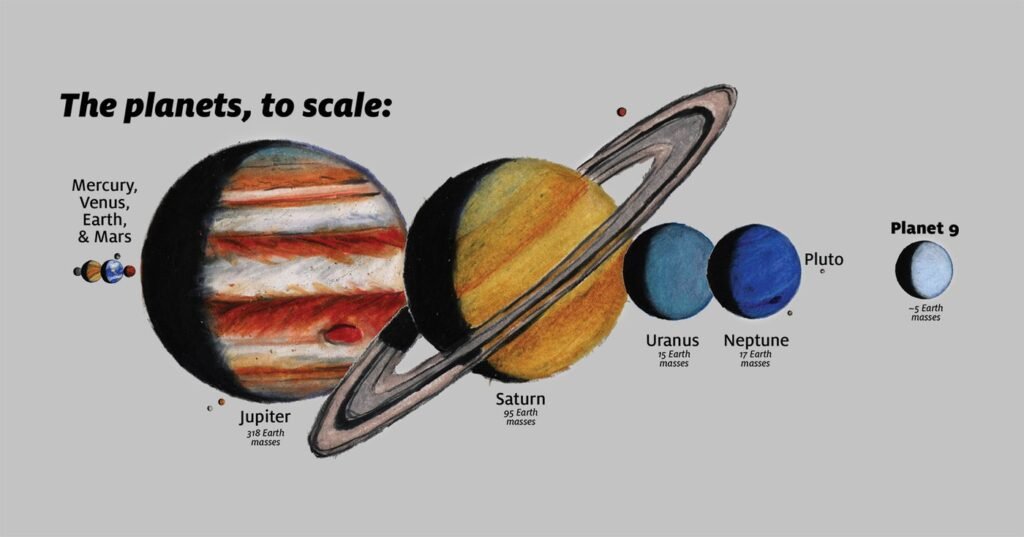Planet Nine-Strange things are happening at the outer edges of our solar system. An object up to ten times the mass of Earth is pulling others towards it. Is it a planet (planet nine), or something else?

Planet Nine
For planetary scientists,planet nine, it was once the boldest declare in a generation: an unseen more planet, as plenty as 10 instances the mass of Earth, lurking on the Solar System’s frontier, past Neptune. But the declare appears an increasing number of shaky, after a group of astronomers said final week that the orbits of a handful of far away lumps of rock are now not bunched collectively through the gravity of Planet Nine, as its proponents believe, however solely appear clustered due to the fact that’s the place telescopes passed off to be looking.
Planet Nine supporters aren’t backing down yet, however one skeptic no longer concerned with the new work says she is “very happy” to see it. The learn about has carried out “a greater uniform analysis” than achieved in the past of the far-off rocky our bodies acknowledged as recognized as Trans-Neptunian objects (TNOs), says astronomer Samantha Lawler of the University of Regina, who has tried and failed to simulate the clustered orbits in pcfashions with an greater planet.
Mike Brown and Konstantin Batygin of the California Institute of Technology made headlines global in 2016 with their prediction for a far away Planet Nine. They based totally their conclusion on a find out about of six TNOs, every smaller than Pluto, in extraordinarily elongated and tilted orbits round the Sun.
The orbits of these “extreme” TNOs have been bunched together, Brown and Batygin said, due to the fact Planet Nine’s gravity had nudged them there over billions of years. Several greater severe TNOs found for the reason that then regarded to cluster as well. “I would argue that the applicable [Planet Nine] facts set is in surprisingly proper shape,” Batygin says.
A group led by way of Kevin Napier of the University of Michigan, Ann Arbor, determined to take a look at whether or not decision bias was once enjoying a role. They gathered 14 in a similar wayfar away TNOs located with the aid of three extraordinary surveys: the Dark Energy Survey (DES), which uses the Blanco Telescope in Chile; the Outer Solar System Origins Survey on the Canada-France-Hawaii Telescope in Hawaii; and a 1/3 that used a range of telescopes. All three had nicely characterised decision biases. None of the 14 TNOs was once amongst the unique six invoked via Brown and Batygin.

Napier says the crew took account of when and the place the telescopes pointed, and how touchy they have been to faint objects. With these data, the crew calculated a “selection function” that varies throughout the sky. And positive enough, the intense TNOs observed via all three surveys had been in or close to areas the place choice feature was once highest, the crew suggested on eleven February in a paper posted to the arXiv and widespreadby using the Planetary Science Journal. As a result, Napier says, the groupought to no longer reject the null speculation that the intense TNOs are uniformly disbursed round the Solar System, which would rob Planet Nine of its foundational evidence. The clustering “is a outcome of the place we seem and when we look,” he says. “There’s no want for any other mannequin to healthy the data.”
Batygin doesn’t be given that conclusion. He factors out that the DES survey seemed mostly in the place of the sky the place the TNO cluster he and Brown recognized resides and discovered extrasevere TNOs. So ruling out clustering is “not logical,” he says. “The greater applicable query to ask is: Can their evaluation distinguish between a clustered and uniform distribution, and the replyseems to be no,” he says.
Napier acknowledges that attempting to draw conclusions from a pattern of 14 TNOs is tricky. “There’s solely so tons statistical energy you can draw with so few objects,” he says. The count is not going to be settled, he adds, till the Vera C. Rubin Observatory—a effective new survey telescope being constructed in Chile—starts to look at in 2023. Its survey will have well-defined choice biases and is in all likeli hood to realizet housands of new severe TNOs. That, Napier says, “will be like Christmas morning.”
We’ve solely been reading the vicinity of the photo voltaic gadget previous the orbit of Neptune for a few many years now, and after a second of introspection it is handy to see why: astronomy out right here is variety of challenging, due to the fact the objects we’re making an attempt to hunt down are a) very, very small and b) very, very a ways away. That makes them difficult to spot.
Besides Pluto, determined by using essentially blind good fortune in 1930, our grasp of the outer photo voltaic device used to be absolutely absent till 1992, when astronomers located their first Kuiper Belt object, a frozen little remnant from the formation of the photo voltaic system, lazily circling the solar in close toideal darkness past Neptune.


